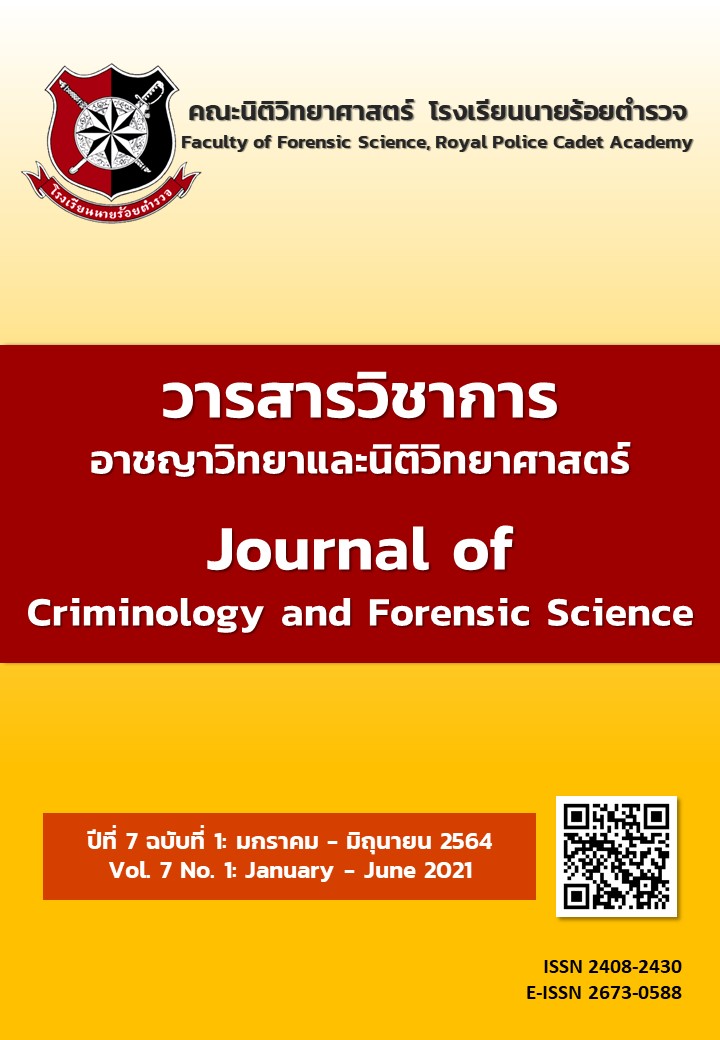การศึกษาผู้ถูกล่วงละเมิดทางเพศและการรับยาป้องกันการติดเชื้อเอชไอวีในโรงพยาบาลตำรวจ
Main Article Content
บทคัดย่อ
การวิจัยครั้งนี้มีวัตถุประสงค์เพื่อศึกษาคุณลักษณะของผู้ถูกล่วงละเมิดทางเพศ ความชุกของการรับยาป้องกันการติดเชื้อเอชไอวีและปัจจัยที่มีความสัมพันธ์ระหว่างการรับยาป้องกันการติดเชื้อเอชไอวีกับผู้ถูกล่วงละเมิดทางเพศที่มารับบริการที่โรงพยาบาลตำรวจ รูปแบบการศึกษาเป็นวิจัยเชิงพรรณนาและเก็บข้อมูลแบบย้อนหลัง กลุ่มตัวอย่างคือผู้ถูกล่วงละเมิดทางเพศที่มารับบริการที่โรงพยาบาลตำรวจ ระหว่างวันที่ 1 มกราคม พ.ศ. 2561 ถึง 31 ธันวาคม พ.ศ. 2561 จำนวน 636 คน เครื่องมือที่ใช้ในการวิจัยเป็นเวชระเบียนผู้ถูกล่วงละเมิดทางเพศในโรงพยาบาลตำรวจ การวิเคราะห์ข้อมูลโดยใช้จำนวนร้อยละ ค่าเฉลี่ย และการทดสอบค่าไคสแควร์ เพื่อหาความสัมพันธ์ของการรับยาของผู้ถูกล่วงละเมิดทางเพศ โดยกำหนดนัยสำคัญทางสถิติที่ระดับ 0.05
ผลการศึกษาพบว่า ผู้ถูกล่วงละเมิดทางเพศเป็นเพศหญิงร้อยละ 91.8 อายุเฉลี่ย 17 ปี การศึกษาส่วนใหญ่อยู่ในระดับชั้นมัธยมศึกษาตอนต้นร้อยละ 38.2 ส่วนใหญ่ไม่มีโรคประจำตัวร้อยละ 94.3 เคยมีเพศสัมพันธ์มาก่อนร้อยละ 49.8 ผู้กระทำส่วนใหญ่เป็นเพื่อนร้อยละ 33 ถูกกระทำเพียงหนึ่งครั้ง ร้อยละ 40.7 ส่วนใหญ่ถูกล่วงละเมิดผ่านทางอวัยวะเพศร้อยละ 86.2 ผู้กระทำไม่ใช้ถุงยางอนามัยร้อยละ 52 ผู้ถูกล่วงละเมิดทางเพศติดเชื้อทางเพศสัมพันธ์ร้อยละ 12.4 ตั้งครรภ์ร้อยละ 7.7 ผู้ถูกล่วงละเมิดทางเพศเข้ารับการตรวจภายใน 72 ชั่วโมงหลังถูกล่วงละเมิดทางเพศร้อยละ 48.3 รับยาป้องกันการติดเชื้อ เอชไอวีร้อยละ 83.3 รับยาจนครบ 28 วันร้อยละ 85.7 ผู้ที่รับยาต่อเนื่องจนครบ 28 วันเข้ารับการตรวจการติดเชื้อเอชไอวีซ้ำที่ 3 เดือนร้อยละ 48.1 ผลการตรวจเป็นลบทุกคน พบผลข้างเคียงจากการรับยา ร้อยละ 4 ปัจจัยที่มีความสัมพันธ์กับการรับยาของผู้ถูกล่วงละเมิดทางเพศจนครบคือผลข้างเคียงจากการรับยาป้องกันการติดเชื้อเอชไอวี
Article Details
เนื้อหาและข้อมูลในบทความที่ลงตีพิมพ์ใน วารสารวิชาการอาชญาวิทยาและนิติวิทยาศาสตร์ โรงเรียนนายร้อยตำรวจ ถิอว่าเป็นข้อคิดเห็นและความรั้บผิดชอบของผู้เขียนบทความโดยตรงซึ่งกองบรรณาธิการวารสาร ไม่จำเป็นต้องเห็นด้วยหรือรับผิดชอบใดๆ
บทความ ข้อมูล เนื้อหา รูปภาพ ฯลฯ ที่ได้รับการตีพิมพ์ใน วารสารวิชาการอาชญาวิทยาและนิติวิทยาศาสตร์ ถือว่าเป็นลิขสิทธิ์ของวารสาร วารสารวิชาการอาชญาวิทยาและนิติวิทยาศาสตร์ หากบุคคลหรือหน่วยงานใดต้องการนำทั้งหมดหรือส่วนหนึ่งส่วนใดไปเผยแพร่ต่อหรือเพื่อกระทำการใดๆ จะต้องได้รับอนุญาตเป็นลายลักษณ์อักษรจาก วารสารวิชาการอาชญาวิทยาและนิติวิทยาศาสตร์ ก่อนเท่านั้น
เอกสารอ้างอิง
Ackerman, D. R., Sugar, N. F., Fine,D. N., & Eckert,L. O. (2006). Sexual assault victims: Factors associated with follow-up care. American Journal of Obstetrics and Gynecology, 194 (6), 1653-1659.
Basile, K. C., Smith, S. G., Liu, Y., Kresnow, M. J., Fasula, A. M., Gilbert, L., &Chen, J. (2018).
Rape-Related Pregnancy and Association with Reproductive Coercion in the U.S. American journal of preventive medicine, 55(6), 770–776.
Centers for disease control and prevention. (2006). Sexually transmitted diseases treatment guidelines, 2006,Morbidity and Mortality Weekly Report, 55(R-11), 1-94.
Center for Disease Control and Prevention. (2020). HIV infection in Bangkok. Retrieved April 15, 2020. from http://www.bangkok.go.th/upload/user/00000150/download/
statistics/HIV_Situation.pdf. (In Thai)
Department of Disease Control, Ministry of Public Health. (2017). Thailand National Guidelines on HIV/AIDS Treatment and Prevention. Retrieved April 20, 2020. fromhttp://www.thaiaidssociety.org/index.php?option=com_content&view=article&id=79&Itemid=86. (In Thai)
DinizI, N.M.F, AlmeidaII L.C.G., Cristina B.S., RibeiroIII, & Macêdo, V.G. (2017). Women victims of sexual violence: adherence to chemoprevention of HIV, 15(1). Retrieved April 20,2020. from https://www.researchgate.net/publication/6432651_Women_victims_of_sexual_violence_Adherence_to_chemoprevention_of_HIV
Griffith, W.F., Ackerman, G.E., Zoellner, C.L., &Sheffield, J.S.,Sexual Assault. (2010). Sexual Assault: A report on human immunodeficiency virus postexposure prophylaxis.Retrieved April 20, 2020.from https://www.hindawi.com/ journals/ogi/2010/196963/.
Independent News Network. (2020). The Police general hospital opened a center to help Children and Women. Retrieved April 15, 2020. from https: //www.sanook.com/news/1062498. (In Thai).
Khaosod Online. (2020). Police general hospital takes care of victims of sexual abuse. Retrieved April 20, 2020. from https://www.khaosod.co.th/around-thailand/news_1237680. (In Thai).
Meel BL. (2005). Incidence of HIV infection at the time of incident reporting, in victims of sexual assault, between 2000 and 2004, in Transkei, Eastern Cape, South Africa. Journal of African Health Sciences. 5(3).
Muriuki, E. M., Kimani, J., Machuki, Z., Kiarie, J., &Roxby, A. C. (2017). Sexual Assault and HIV Postexposure Prophylaxis at an Urban African Hospital. AIDS patient care and STDs, 31(6), 255-260.
National health security office. (2016). National health security fund management 2016, Budgeting for HIV infection services and AIDS patients. 1st ed. Bangkok: Sangchan Printing LP. (In Thai).
Pett, W. (2019). What are the side-effects of post-exposure prophylaxis (PEP)?. Retrieved April 20, 2020. from https://www.aidsmap.com/about-hiv/what-are-side-effects-post-exposure-prophylaxis-pep.
Phansiniramon, K. (2006). Adherence of antiretroviral therapy in HIV-infected/AIDS patients : application of Transtheoretical model. Master of Pharmacy Thesis, Chulalongkorn University, Bangkok. (In Thai).
Ruengsaen, A., Teerapong S., Janpanichjaroen, A., andKalampakorn, D. (2017). Correlated Factors of Sexually Transmitted Infections in Sexual Assault victim Receiving Services at Police General Hospital. Journal of The Police Nurses, 9(1). 197-205. (In Thai).
Tuengwiwat, S. (2015). Outcome of Antiretroviral Drug Use in HIV-Patients at Mabammarit Hospital. Journal of Medical Technology,29(1), 161-169. (In Thai).


